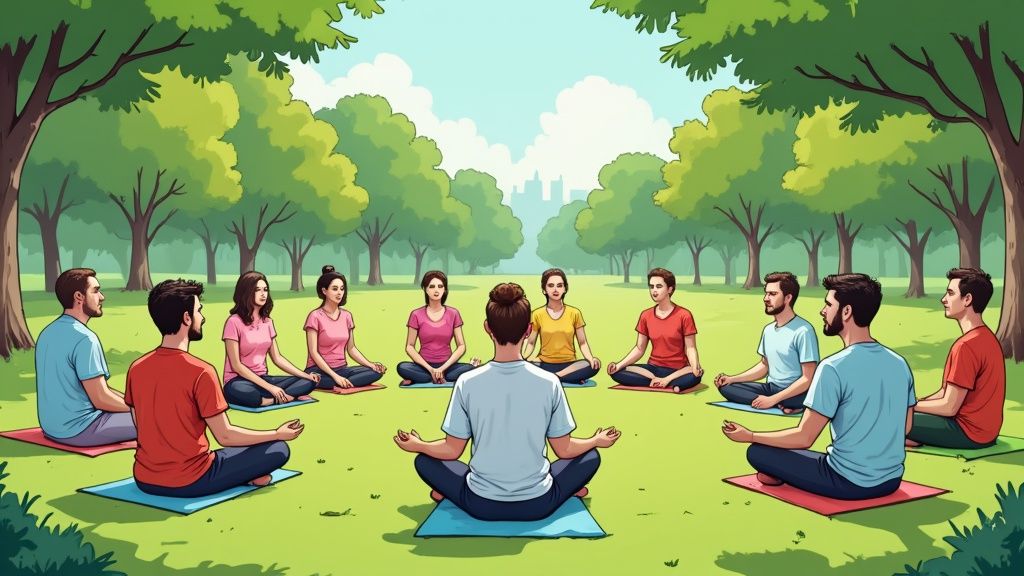How to Practice Mindfulness: A Complete Guide for Beginners


Understanding Mindfulness in the Modern World

Mindfulness has becme essentail for managng stress and improving wellbieng, going far beyond just being a passing trend. As our lives grow busier and more complx, understanding what mindfullness realy means - and how it can help us - becmes increassingly important.
Defining Mindfulness
While many people think mindfulness and meditation are the same thing, they're actually quite different. Meditation is just one way to practice mindfulness. At its core, mindfulness means paying attention to what's happening right now - our thoughts, feelings, physical sensations, and surroundings - without judging these experiences as good or bad. When we're mindful, we simply notice what's going on without getting caught up in it.
Mindfulness in Contemporary Society
More people are discovering how mindfulness can help them handle daily challenges. Business professionals use it to make better decisions and stay focused. Healthcare providers now include mindfulness techniques when treating anxiety, depression, and chronic pain. The numbers tell a compelling story - according to recent data, 17.3% of U.S. adults practiced meditation in 2022, up from just 7.5% in 2002. In fact, meditation has become the most widely used complementary health practice. Learn more about mindfulness research and statistics.
Dispelling Common Misconceptions
As mindfulness grows more popular, some common myths need clearing up. Many think mindfulness means emptying your mind of thoughts - it doesn't. Instead, it's about observing your thoughts without getting tangled in them. Others believe you need to stay present every second - that's not true either. Mindfulness is more about gently returning your attention to the present moment whenever you notice your mind has wandered. And contrary to what some think, mindfulness isn't about avoiding negative emotions. Rather, it helps us accept and work through all our feelings, even the difficult ones.
The Transformative Power of Mindfulness
When we practice mindfulness regularly, we develop better self-awareness and emotional balance. This helps us handle life's ups and downs with more skill and steadiness. Understanding these basics sets the stage for bringing mindfulness into our daily routines in practical, helpful ways.
Building Your Daily Mindfulness Foundation
Creating a lasting mindfulness practice doesn't require dramatic life changes. By incorporating simple techniques into your existing routine, you can develop habits that enhance your daily wellbeing and mental clarity.
Starting Small, Thinking Big
Learning mindfulness is like building any new skill - it's best to begin with manageable steps. Start with just 5-10 minutes per day of focused practice, then gradually increase the duration as it becomes more natural. This gentle approach helps you build confidence while avoiding overwhelm. Remember that consistency matters more than perfection.
Finding Your Mindfulness Rhythm
The ideal time to practice mindfulness is whatever works best for your schedule. Some people feel most focused first thing in the morning, while others prefer taking mindful breaks during the day or winding down in the evening. Take time to experiment and discover which timing feels most sustainable for your lifestyle.
Creating a Supportive Environment
While mindfulness can be practiced anywhere, having a dedicated space can help you stay focused. Consider setting up a quiet corner at home, finding a peaceful spot outdoors, or even designating an area at your desk. Simple touches like soft lighting or pleasant scents can make your practice more inviting. Remember to minimize distractions by silencing notifications.
Adapting Mindfulness to Your Lifestyle
One of mindfulness's greatest strengths is how easily it fits into different lifestyles. You can practice through formal meditation or build mindful moments into everyday activities. For instance, try eating mindfully by noticing flavors and textures, or practice mindful walking by focusing on each step. Recent research shows even brief daily practice makes a difference - just 10 minutes per day was found to reduce depression by 19.2%, improve wellbeing by 6.9%, and decrease anxiety by 12.6%. Learn more about the research findings.
Building Consistency and Overcoming Challenges
Creating a daily mindfulness practice takes patience and persistence. There will naturally be days when maintaining your routine feels difficult. When this happens, be gentle with yourself and simply return to your practice when you can. Remember that even a few mindful moments can make a positive difference in your day.
Mastering Mindfulness in Professional Settings

Mindfulness has become an essential skill for achieving excellence at work while maintaining balance and authenticity. By practicing mindful awareness throughout the workday, professionals can build mental resilience and sharpen their focus to handle demanding roles more effectively.
Mindful Moments in the Workday
Building mindfulness into your work routine doesn't require major changes. Small, deliberate pauses can make a significant difference in your day. Think of these moments as brief mental reset points that help you stay centered.
Mindful Email Management: Set specific times to process emails with full attention rather than constantly checking your inbox. Focus on one message at a time.
Conscious Meetings: Take a few deep breaths before each meeting to get centered. Practice active listening by paying attention to both words and body language.
Mindful Breaks: Get up from your desk briefly each hour to stretch, walk, or do breathing exercises. These short breaks prevent mental fatigue and restore focus.
Navigating High-Stress Situations
Work inevitably brings challenging deadlines, complex projects, and difficult conversations. A mindful approach helps you handle these pressures more skillfully.
Recognizing Stress Triggers: Notice which situations consistently cause you to feel overwhelmed. Building this self-awareness is key to managing workplace stress.
Responding, Not Reacting: When stress hits, pause and take a few breaths before acting. This creates space to choose a thoughtful response rather than react emotionally.
Reframing Challenges: Use mindfulness to see difficulties as chances to learn and grow rather than just obstacles to overcome.
The Growing Trend of Workplace Mindfulness
The adoption of mindfulness practices like yoga and meditation in professional settings continues to expand. Research shows significant growth - between 2002 and 2012, yoga participation doubled among U.S. workers, while meditation rates also rose substantially. This points to wider recognition of mindfulness benefits in the workplace. Learn more about workplace mindfulness trends.
Cultivating a Mindful Mindset
Developing mindfulness at work is an ongoing practice that requires patience and commitment. With consistent effort to integrate these techniques into your daily routine, you can build greater mental clarity, emotional balance, and overall resilience - essential qualities for navigating professional challenges successfully.
Elevating Your Practice with Advanced Techniques
A strong foundation in mindfulness can open doors to deeper levels of practice. Once you've established consistent mindfulness habits, you can begin exploring more nuanced techniques that expand awareness and self-understanding in powerful ways.
Exploring Advanced Mindfulness Practices
Building on the core skills of present-moment awareness and non-judgmental observation, several advanced practices can take your mindfulness journey further:
Loving-Kindness Meditation: This practice helps develop genuine compassion, starting with self-directed kindness and gradually extending to others - from close friends to challenging relationships.
Mindful Movement: By bringing focused attention to physical activities like yoga, walking, or Tai Chi, you can develop a stronger mind-body connection and embodied awareness.
Contemplative Inquiry: Through guided self-reflection on meaningful questions about identity and purpose, this practice fosters deeper wisdom and understanding.
Finding Your Path Forward
Not every advanced technique will resonate with each practitioner. Some people naturally connect with loving-kindness practices, while others find mindful movement more engaging. The key is discovering which methods align with your learning style and goals through patient exploration.
Before diving into advanced practices, ensure you have a solid grasp of foundational skills like breath awareness and body scanning. Rushing ahead without these basics often leads to frustration and diminished benefits. Take time to build confidence in core techniques first.
Making Advanced Practices Part of Your Routine
The best way to incorporate new techniques is gradually. Start by adding just 5 minutes of an advanced practice after your regular mindfulness session. As you grow more comfortable, slowly increase the duration. This measured approach helps you maintain consistency while exploring new territory.
Research shows that dedicated mindfulness practice leads to real cognitive and emotional growth. Studies have found improvements in metacognitive awareness, reduced mental rumination, and better attention control. Discover more insights about mindfulness meditation. By staying patient and curious as you explore advanced techniques, you'll uncover unique insights that deepen your practice in meaningful ways.
Navigating Common Mindfulness Obstacles

Everyone faces challenges when learning mindfulness practices. Let's explore some common hurdles and practical ways to work through them.
Taming the Mental Chatter
The constant stream of thoughts in our minds can make focusing difficult. This mental activity is completely normal and fighting against it only creates more tension. Instead, try viewing your thoughts like clouds in the sky - notice them passing by without getting caught up in their content. When your mind wanders, gently guide your attention back to your breath.
Addressing Physical Discomfort
Many beginners experience physical discomfort like back pain or restless legs during practice. Don't force yourself to maintain an uncomfortable position. Feel free to adjust your posture or use cushions and props for support. The key is accepting sensations without resistance while maintaining gentle awareness of your breath and body.
Overcoming Scheduling Conflicts
Finding time for mindfulness can be challenging. Rather than aiming for long meditation sessions, try incorporating brief moments of mindful awareness throughout your day. Take three mindful breaths while waiting for coffee to brew or practice presence during your morning commute. Small, consistent practices add up over time.
Managing Skepticism
It's natural to question whether mindfulness really "works" or feel impatient for results. Notice these doubts without judgment while remembering that, like any skill, mindfulness develops gradually with practice. Start with achievable goals like one minute of mindful breathing. If others express skepticism, simply share your personal experience rather than trying to convince them.
Tailoring Your Practice
There's no single "right way" to practice mindfulness. Some people connect best with walking meditation, while others prefer guided practices or body scans. During busy periods, quick grounding exercises may serve you better than longer sits. Stay flexible and adapt your approach based on your needs and circumstances. The most effective practice is one you'll actually do consistently.
Build your mindfulness practice step by step, meeting obstacles with patience and self-compassion. Focus on progress rather than perfection. Small shifts in awareness can lead to meaningful changes over time.
Creating Your Lifelong Mindfulness Journey

Mindfulness is best viewed as an ongoing journey rather than a destination. Making it a lifelong practice requires more than just daily meditation - it's about growing, adapting, and continuously discovering new aspects of yourself. Let's explore how to develop mindfulness into a sustainable, long-term path.
Setting Meaningful Goals and Measuring Progress
Start by getting clear on your intention with mindfulness. Think about what specifically you want to achieve - whether it's managing stress better, improving your focus, or handling emotions more skillfully. Having defined goals gives your practice direction and purpose.
Progress in mindfulness shows up in subtle but meaningful ways. While tracking meditation minutes is helpful, real growth is seen in daily life moments - staying calm during a tense conversation, being more present with loved ones, or catching yourself before reacting automatically. Notice and celebrate these small shifts.
Building a Supportive Community
Having others to share your mindfulness journey with can make a big difference. When you connect with fellow practitioners, you gain encouragement, accountability, and a space to discuss both challenges and breakthroughs. Consider these options for finding community:
Local Meditation Groups: Search for mindfulness centers or groups in your area to connect with others in person.
Online Forums and Communities: Explore digital platforms to find support and connect with practitioners worldwide.
Identifying Quality Teachers and Resources
As you deepen your practice, working with experienced teachers becomes valuable. The right guide can help you navigate challenges safely and effectively. When choosing a teacher, consider:
Teacher Credentials and Experience: Research their background and training in mindfulness practices
Authenticity and Resonance: Select someone whose teaching style and approach feels genuine and helpful for you
Creating a Personalized Path
There's no single "right way" to practice mindfulness. Every person needs to find methods that work for their unique personality and life circumstances. Try different techniques and be willing to adjust your approach as needed. Your practice should fit naturally into your life while supporting your growth.
By following these strategies, you can build a mindfulness practice that grows with you over time, bringing lasting positive changes to your daily life and overall wellbeing.
Are you ready to take your coaching skills to the next level and empower your clients to achieve lasting transformation? Visit Coaching Hub today to discover valuable resources and insights to enhance your coaching practice and guide your clients toward greater self-awareness and personal growth.